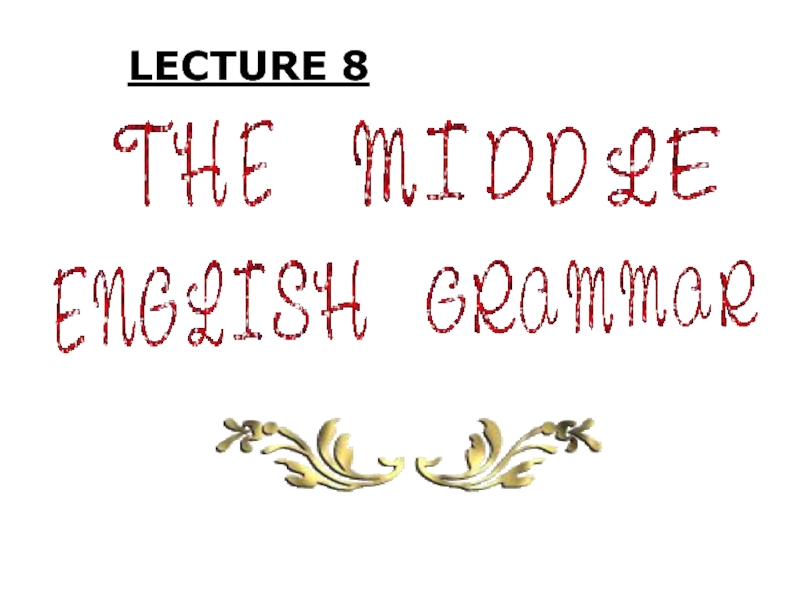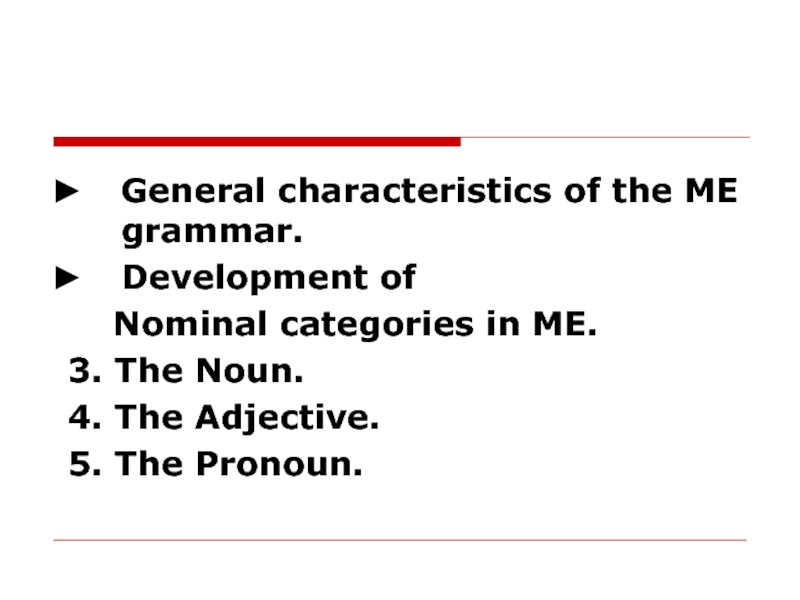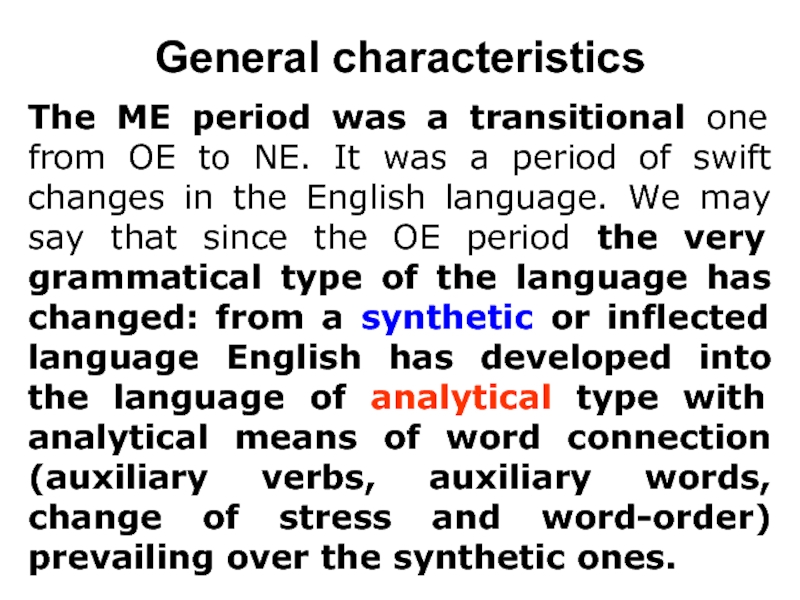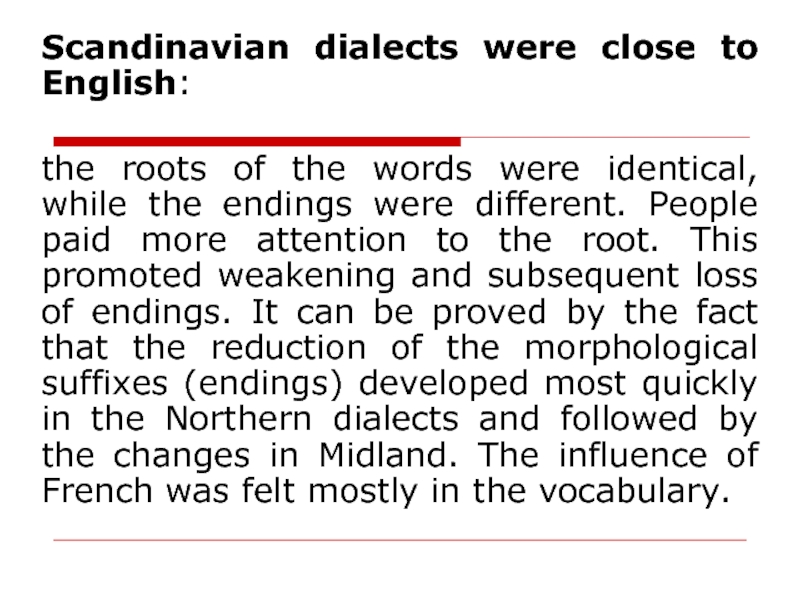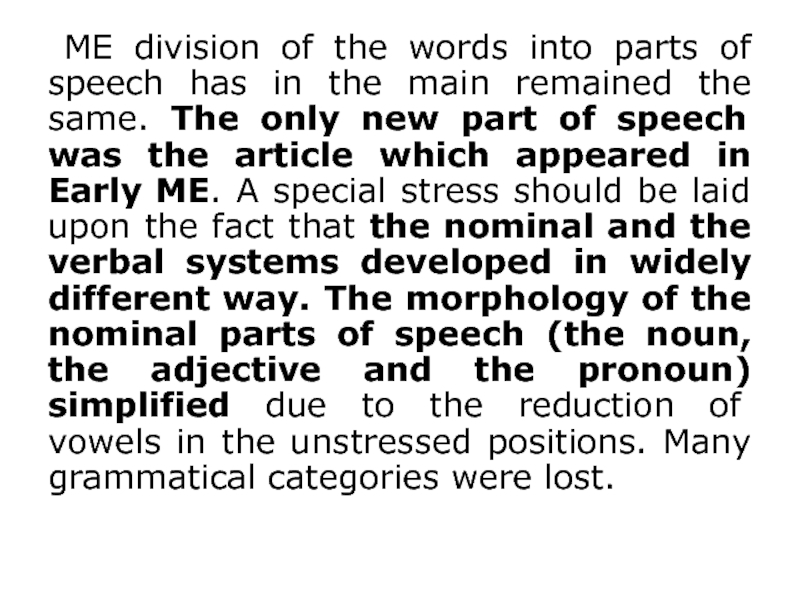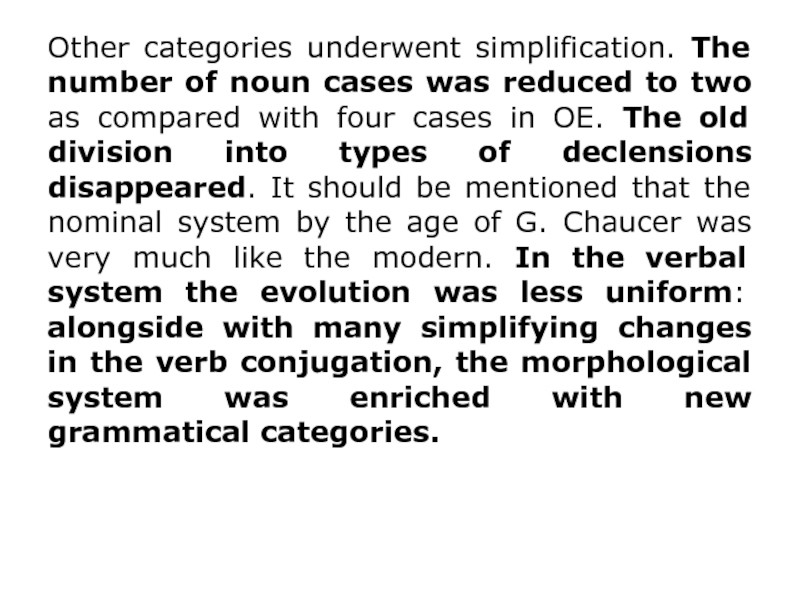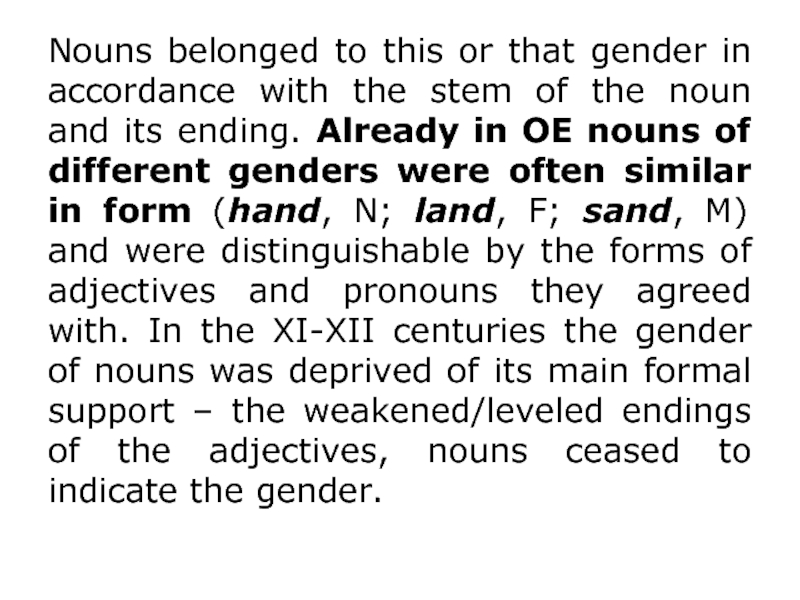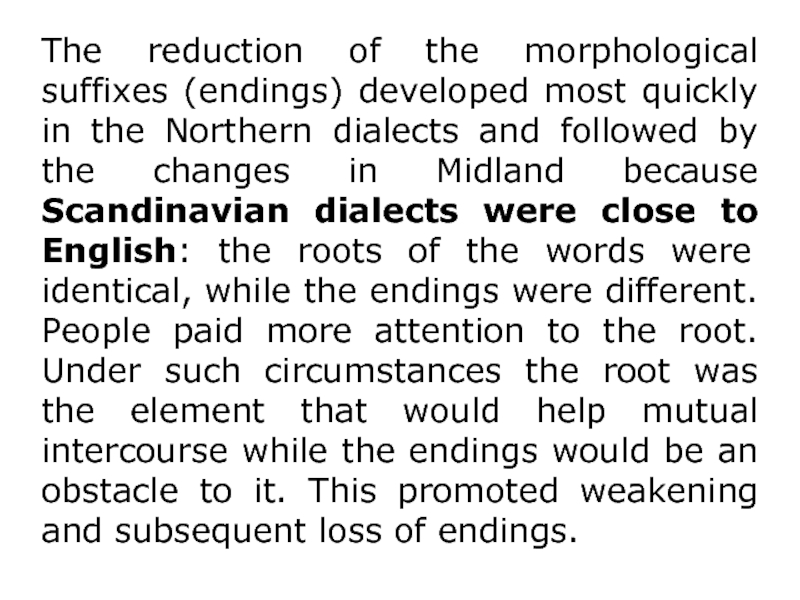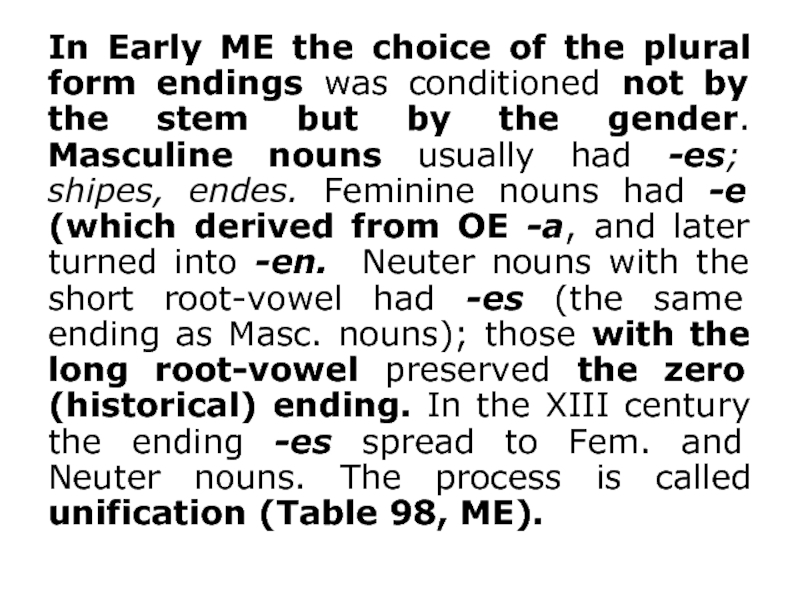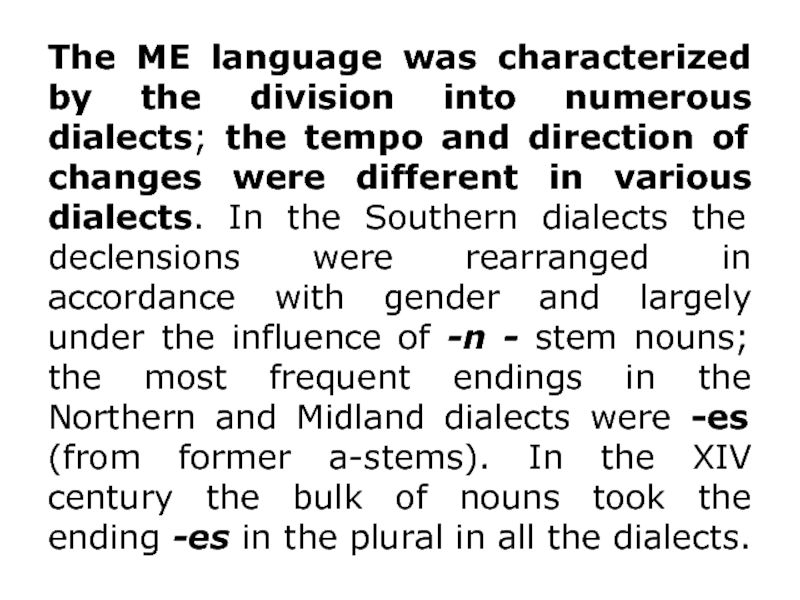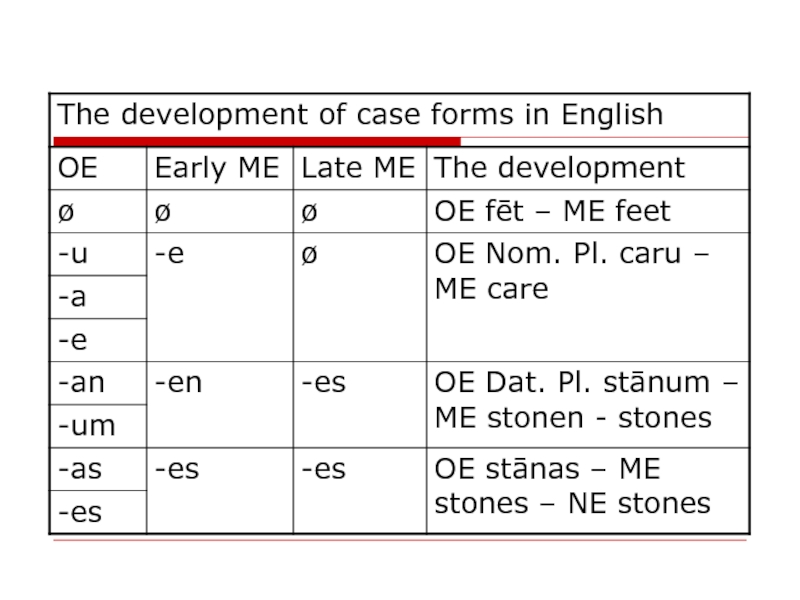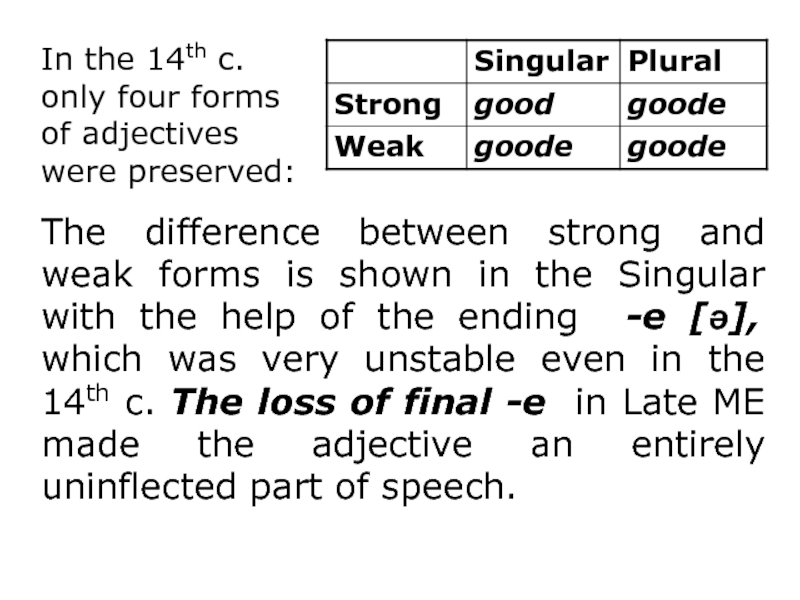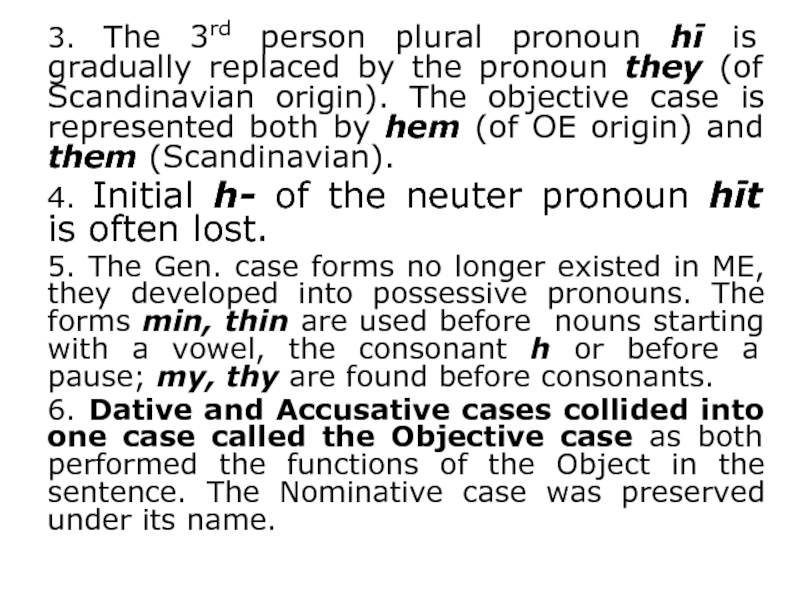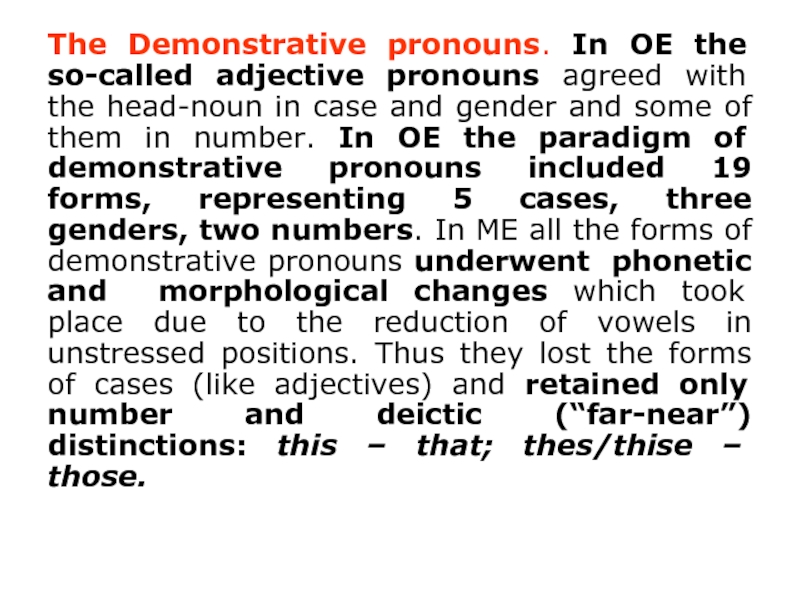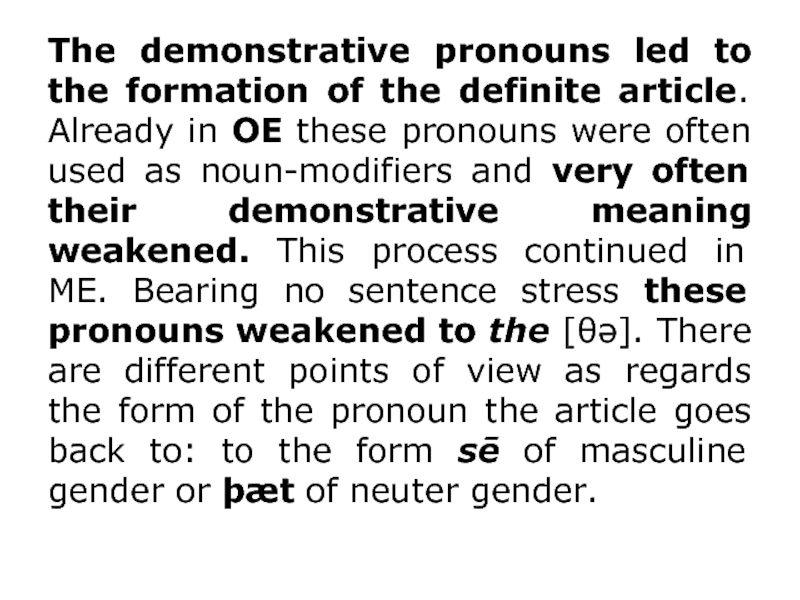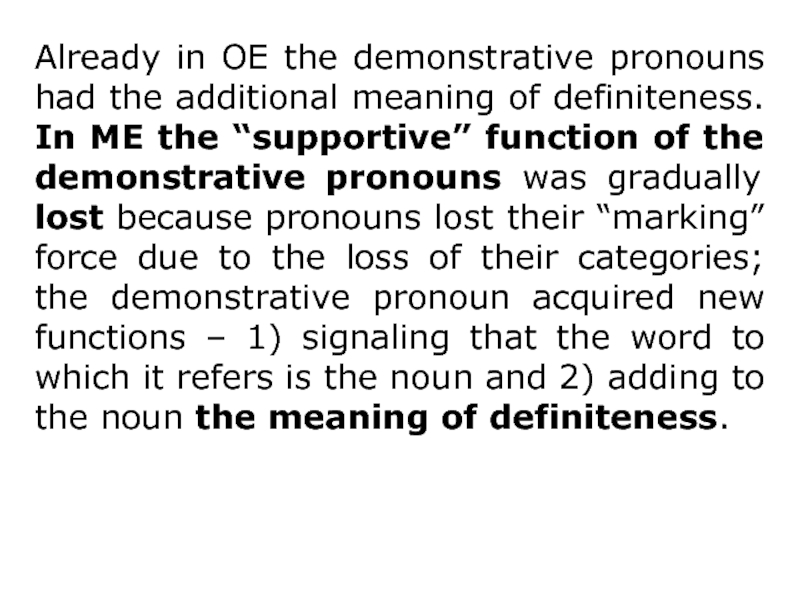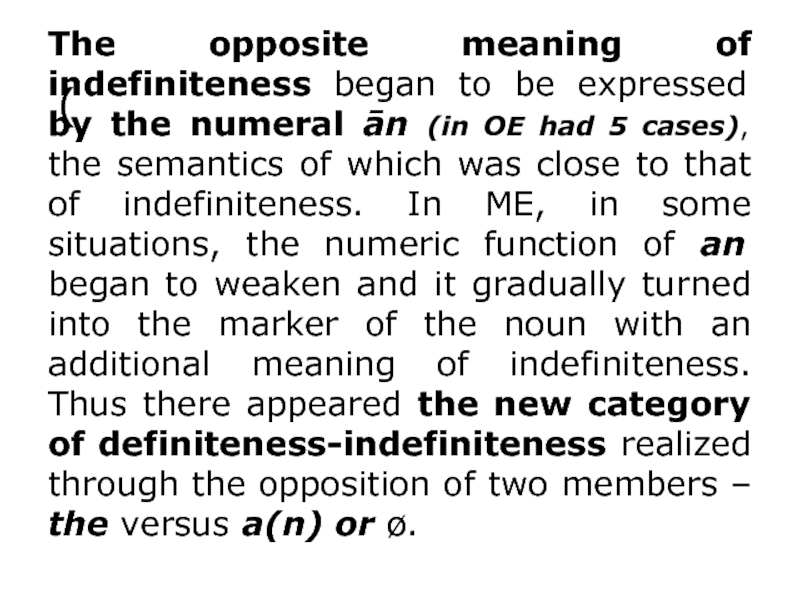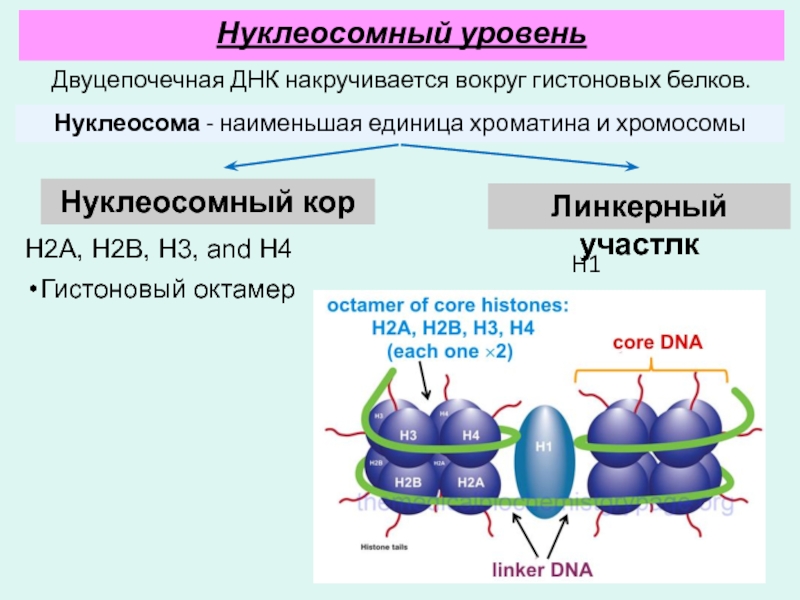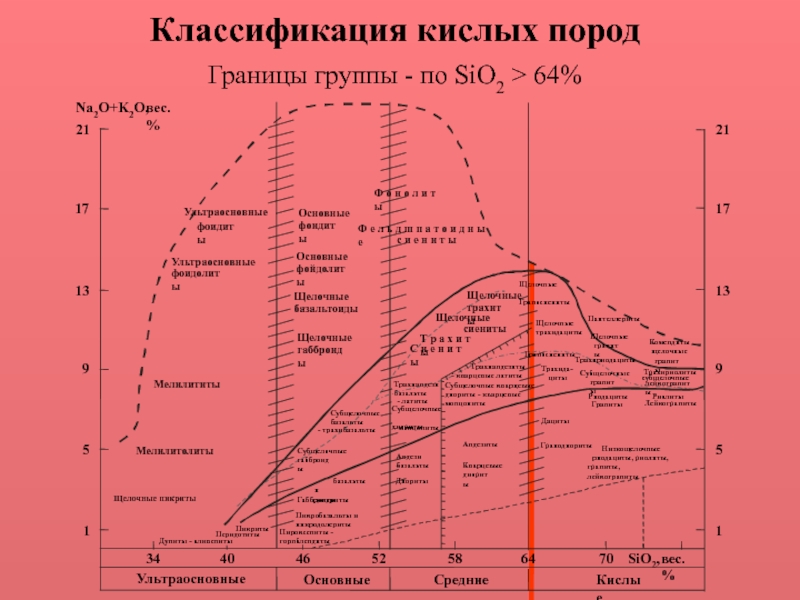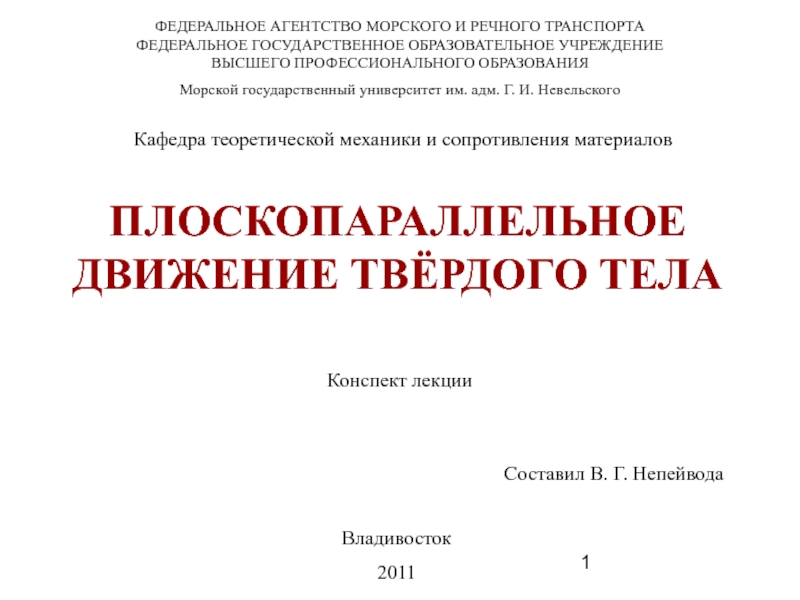Разделы презентаций
- Разное
- Английский язык
- Астрономия
- Алгебра
- Биология
- География
- Геометрия
- Детские презентации
- Информатика
- История
- Литература
- Математика
- Медицина
- Менеджмент
- Музыка
- МХК
- Немецкий язык
- ОБЖ
- Обществознание
- Окружающий мир
- Педагогика
- Русский язык
- Технология
- Физика
- Философия
- Химия
- Шаблоны, картинки для презентаций
- Экология
- Экономика
- Юриспруденция
LECTURE 8
Содержание
- 1. LECTURE 8
- 2. General characteristics of the ME grammar.Development of
- 3. General characteristics The ME period was a
- 4. The syntax came to play a more
- 5. The main direction of development for the
- 6. The Russian scholar Prof. A. Smirnitsky considered
- 7. Scandinavian dialects were close to English: the
- 8. ME division of the words into
- 9. Other categories underwent simplification. The number of
- 10. Changes in the grammatical categories of nouns.
- 11. Nouns belonged to this or that gender
- 12. In Chaucer’s works gender is already a
- 13. The category of case. During the ME
- 14. The loss of cases started with the
- 15. The reduction of the morphological suffixes (endings)
- 16. The category of number. It proved to
- 17. In Early ME the choice of the
- 18. The ME language was characterized by the
- 19. Слайд 19
- 20. In Late ME the ending –es
- 21. The Adjective in ME. The Adjective in
- 22. In the 14th c. only four
- 23. In OE the forms of the degrees
- 24. The Pronoun in ME. In OE personal
- 25. 3. The 3rd person plural pronoun hī
- 26. The Demonstrative pronouns. In OE the so-called
- 27. The demonstrative pronouns led to the formation
- 28. Already in OE the demonstrative pronouns had
- 29. (The opposite meaning of indefiniteness began to
- 30. thank you
- 31. Скачать презентанцию
General characteristics of the ME grammar.Development of Nominal categories in ME.3. The Noun. 4. The Adjective.5. The Pronoun.
Слайды и текст этой презентации
Слайд 3General characteristics
The ME period was a transitional one from
OE to NE. It was a period of swift changes
in the English language. We may say that since the OE period the very grammatical type of the language has changed: from a synthetic or inflected language English has developed into the language of analytical type with analytical means of word connection (auxiliary verbs, auxiliary words, change of stress and word-order) prevailing over the synthetic ones.Слайд 4The syntax came to play a more important role in
the language than the morphology of the word. The proportion
of the synthetic forms in ME became very small since many of OE synthetic forms had been lost: (1) the grammatical prefixes practically went out of use; (2) suppletive form-building was confined to a few words; (3) sound alternations were not productive and their application was generally reduced; (4) inflexions continued to be used but they were less varied.Слайд 5The main direction of development for the nominal parts of
speech – MORPHOLOGICAL SIMPLIFICATION.
Simplifying changes began in PG, continued in
OE and were intensified in ME. The situation in the language gave H. Sweet the right to characterize ME as the period of leveled endings. Many scholars tried to find the reasons for so drastic changes in the morphological system of English. Some of them explained it by the reduction of endings, others – by the changes in the manner of thinking.Слайд 6The Russian scholar Prof. A. Smirnitsky considered that as regards
English both factors promote each other under specific historical conditions
of the development of the English language: phonetic reduction was caused by the shift of stress which, in its turn, promoted the changes in morphology. Many morphological forms became homonymous and did not show the difference in the grammatical meaning of the words. These processes were precipitated by the Scandinavian and the Norman conquests.Слайд 7Scandinavian dialects were close to English:
the roots of the
words were identical, while the endings were different. People paid
more attention to the root. This promoted weakening and subsequent loss of endings. It can be proved by the fact that the reduction of the morphological suffixes (endings) developed most quickly in the Northern dialects and followed by the changes in Midland. The influence of French was felt mostly in the vocabulary.Слайд 8 ME division of the words into parts of speech
has in the main remained the same. The only new
part of speech was the article which appeared in Early ME. A special stress should be laid upon the fact that the nominal and the verbal systems developed in widely different way. The morphology of the nominal parts of speech (the noun, the adjective and the pronoun) simplified due to the reduction of vowels in the unstressed positions. Many grammatical categories were lost.Слайд 9Other categories underwent simplification. The number of noun cases was
reduced to two as compared with four cases in OE.
The old division into types of declensions disappeared. It should be mentioned that the nominal system by the age of G. Chaucer was very much like the modern. In the verbal system the evolution was less uniform: alongside with many simplifying changes in the verb conjugation, the morphological system was enriched with new grammatical categories.Слайд 10Changes in the grammatical categories of nouns. The OE noun
was characterized by gender, number and case and had a
rather complicated system of declensions based on the earlier division into stems and correlated with gender. Gender of nouns in English never was a purely grammatical category. Nouns were not changed according to different genders, but each noun belonged to a certain gender. It was a lexico-grammatical category.Слайд 11Nouns belonged to this or that gender in accordance with
the stem of the noun and its ending. Already in
OE nouns of different genders were often similar in form (hand, N; land, F; sand, M) and were distinguishable by the forms of adjectives and pronouns they agreed with. In the XI-XII centuries the gender of nouns was deprived of its main formal support – the weakened/leveled endings of the adjectives, nouns ceased to indicate the gender.Слайд 12In Chaucer’s works gender is already a purely lexical category,
like it is in ModE. The gender is referred to
as “he” or “she”, if nouns denote living beings and as “it” if they denote animals or inanimate things. Since the very beginning of the ME period the natural feminine gender of such ME words as wimman, meiden began to prevail over the grammatical masculine and neuter. The other two categories of nouns, case and number, were preserved in a modified shape.Слайд 13The category of case. During the ME period the four-case
system which had existed in OE turned into a two-case
system. It was a slow process that took many hundred years. Already in OE there were homonymous forms in some declensions: N. and Acc., both Sg. and Pl. of a-stem declension (N. Sing. stān – A. Sing. stān, N. Pl. stānas – A. Pl. stānas); G., D. and Acc. Sg. of ō-stem declension.Слайд 14The loss of cases started with the Northern dialects where
homonymy was very high: not a single noun had eight
case-forms (Table 75, 76)Слайд 15The reduction of the morphological suffixes (endings) developed most quickly
in the Northern dialects and followed by the changes in
Midland because Scandinavian dialects were close to English: the roots of the words were identical, while the endings were different. People paid more attention to the root. Under such circumstances the root was the element that would help mutual intercourse while the endings would be an obstacle to it. This promoted weakening and subsequent loss of endings.Слайд 16The category of number. It proved to be the most
stable of all the nominal categories. The noun preserved the
distinction of the two numbers (in countables). The plural forms in OE were formed by different endings, depending on the stem and gender (Table 40). The nouns could have in the Nominative plural the endings -as, -a, -u, -e, zero, -an, also sound interchange in the roots of nouns of the corresponding declension (e.g. OE stān – stānas, scip – scipu, sunu – suna, nama - naman).Слайд 17In Early ME the choice of the plural form endings
was conditioned not by the stem but by the gender.
Masculine nouns usually had -es; shipes, endes. Feminine nouns had -e (which derived from OE -a, and later turned into -en. Neuter nouns with the short root-vowel had -es (the same ending as Masc. nouns); those with the long root-vowel preserved the zero (historical) ending. In the XIII century the ending -es spread to Fem. and Neuter nouns. The process is called unification (Table 98, ME).Слайд 18The ME language was characterized by the division into numerous
dialects; the tempo and direction of changes were different in
various dialects. In the Southern dialects the declensions were rearranged in accordance with gender and largely under the influence of -n - stem nouns; the most frequent endings in the Northern and Midland dialects were -es (from former a-stems). In the XIV century the bulk of nouns took the ending -es in the plural in all the dialects.Слайд 20 In Late ME the ending –es was a dominant
marker of nouns in the Plural
In Early NE it extended
to more nouns (English words + new words), which built their Plural in different way. Several nouns (former belonging to root stems) however retain their OE Pl. with the mutated vowel (OE mann – menn, foot – feet etc.).Children, brethren didn’t belong to weak declension!!!
Слайд 21The Adjective in ME.
The Adjective in ME underwent greater
simplifying changes than any other part of speech. It lost
all its grammatical categories (with the exception of the degrees of comparison). In OE the adjective was declined and had five cases, two numbers and two types of declensions, weak and strong, which helped to distinguish between specific meanings of the nouns they referred to. In late OE the agreement with the noun became weaker and in the XII c. was lost altogether.The Adj. lost its grammatical categories in the following order: Gender – Case - Number
Слайд 22In the 14th c. only four forms of adjectives were
preserved:
The difference between strong and weak forms is shown
in the Singular with the help of the ending -e [ə], which was very unstable even in the 14th c. The loss of final -e in Late ME made the adjective an entirely uninflected part of speech.Слайд 23In OE the forms of the degrees of comparison were
built with the help of suffixes -ra for the comparative
degree and -ost for the superlative degrees. Sometimes suffixation was accompanied by an alternation of the root vowel. A few adjectives had suppletive forms. In ME the suffixes were weakened to -er and –est correspondingly. The sound alternation became less frequent. Besides, there appeared parallel forms with and without alternation: ME long – lenger - lengest and long – longer - longest. A few adjectives preserved suppletive forms (good, much).The most important innovation in the adjectival system in ME was the growth of analytical forms of the degrees of comparison (adv. moore /most).
Слайд 24The Pronoun in ME. In OE personal pronouns had 3
genders (in the 3rd person Sg.), 4 cases, 3 numbers
(Sg., Pl., Dual) in the 1st and the 2nd persons. In ME personal pronouns underwent considerable changes:1. Dual number pronouns have disappeared (1st person wit, 2nd person ʒit).
2. OE hēō (the feminine pronoun of the third person Sg.) is gradually replaced by the ME shō or shē. The origin of these forms is still disputable. They might have developed from the OE feminine demonstrative pronoun sēo or were borrowed from Scandinavian.
OE hēō (f) > ME hē (f)
OE hē (m) > ME hē (m)
Слайд 253. The 3rd person plural pronoun hī is gradually replaced
by the pronoun they (of Scandinavian origin). The objective case
is represented both by hem (of OE origin) and them (Scandinavian).4. Initial h- of the neuter pronoun hīt is often lost.
5. The Gen. case forms no longer existed in ME, they developed into possessive pronouns. The forms min, thin are used before nouns starting with a vowel, the consonant h or before a pause; my, thy are found before consonants.
6. Dative and Accusative cases collided into one case called the Objective case as both performed the functions of the Object in the sentence. The Nominative case was preserved under its name.
